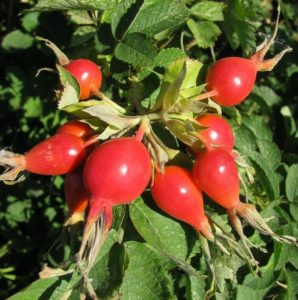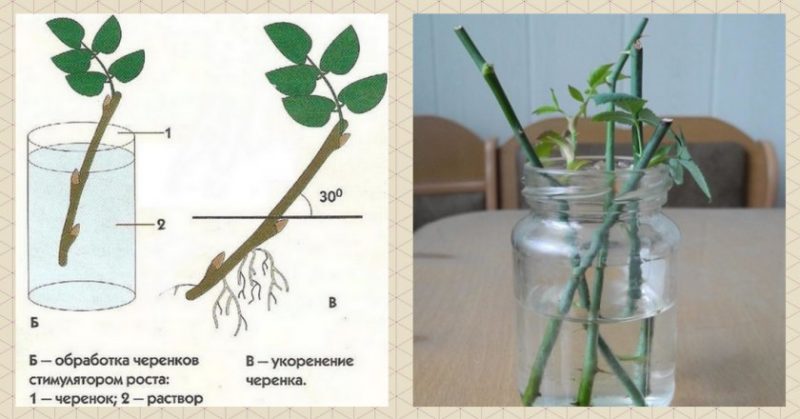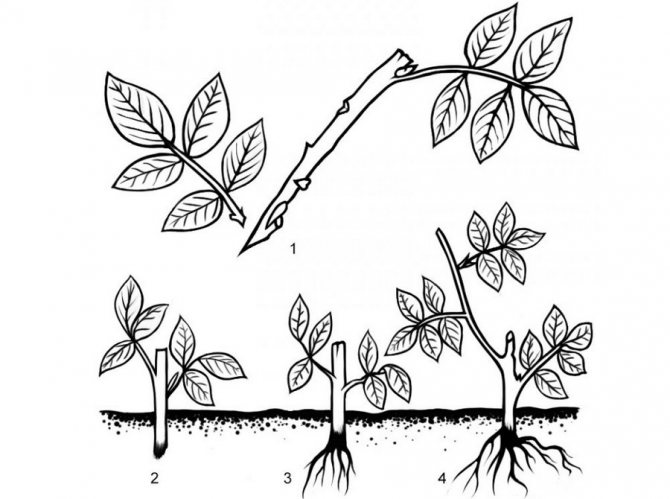When and how to propagate rose hips by cuttings in summer correctly
Rosehip, which combines beauty and benefit, has become a very popular plant in home gardening. To increase the population of culture, summer residents resort to different methods of its reproduction. However, practice has shown that the most progressive of them is grafting. The method is available even for novice gardeners. It is important to know how the rose hips reproduce and when to carry out the procedure.
The content of the article
Is it possible to propagate rose hips by cuttings in summer
The summer period is accompanied by the longest daylight hours and the most comfortable weather for rooting cuttings, so experts consider it the most suitable time for propagation of culture.
In summer, sap flow in plants is suspended, so that when cutting off shoots for cutting cuttings, the dog rose is not injured.
Advantages and disadvantages of summer cuttings

The procedure for breeding a shrub in the summer has many advantages:
- Cuttings root and take root much faster (provided that the planting material is properly prepared, as well as subsequent competent care).
- The seedlings have enough time to adapt to the open ground, they are more likely to survive in winter frosts.
- This is a simple and free way to obtain planting material, allowing you to multiply any variety you like.
- Plants grown from summer cuttings do not form root shoots.
- Preservation of varietal characteristics of the mother bush.
The summer event also has disadvantages:
- In hot and dry weather, the condition of the seedlings worsens, they require more attention: they are sheltered from the scorching sun, they are watered more often and more abundantly.
- After cutting, the starting material is immediately determined for rooting, in contrast to spring and autumn cuttings, when the procedure is postponed at will.
When to cut a rosehip in summer
According to the recommendations of experts, the beginning of June is the best time to harvest green cuttings. In this case, they have time to grow roots and prepare for the winter cold. Lignified shoots are cut in August.
Important! Vegetative parts cannot be harvested during the flowering period. The sources will not take root, and the yield of the mother plant will decrease.
In the summer, cutting of the material is carried out in the morning or in the evening, when the sun is inactive and the green mass contains the most moisture. If possible, the event is postponed to cloudy but dry days. The optimum temperature for the procedure is + 24 ... + 26 ° C.
Auspicious days
Many gardeners believe that the phases of the moon have a great impact on plant growth and survival.
In this regard, all activities in the garden and in the garden are associated with the lunar calendar, considering that on favorable days the plant develops more actively. Consequently, the survival rate of cuttings increases.
They are harvested only on the growing moon on the following days:
- June - 1-4, 21-31;
- July - 22-25;
- August - 19-22.
Selection and preparation of cuttings
The breeding process of rose hips begins with the preparation of planting material - green and lignified cuttings, as well as air layers.
Greens
They are used to breed almost all types and varieties of rose hips. Bushes are subject to reproduction, under which nitrogen, phosphorus and potash fertilizers were regularly applied and pruned in time.
Cuttings should not be taken from wild and unkempt plants. They take root well, but there is a possible risk of infection with fungal, bacterial and viral diseases.
Attention! Cutting is carried out only with a well-sharpened tool (knife or pruner), so as not to damage the vascular system of the plant.
How to propagate rose hips by cuttings in summer:
- Choose a healthy bush 4-7 years old. The best part of it for grafting is the lower sections of the strong side branches, they take root faster.
- They find a green shoot, which has just begun to lignify at the base. The younger it is, the faster the roots form, although too young it is more prone to decay.
- It is cut off and divided into pieces 12-15 cm long, taking into account that each cut cut should have 3-4 buds.
- 1 cm recede from the upper kidney and a straight cut is made, the next one is performed under the lower kidney at an acute angle (5 mm recede). Leaves will develop from the top node, and the root will develop from the bottom.
- The lower leaves with petioles are removed so as not to rot, the rest are shortened by half. Thus, moisture evaporation from plants is reduced.
Lignified
The breeding method by lignified cuttings is similar to the previous one. But in this case, they take an annual shoot for harvesting, which continues to grow, and the main part of it has already become lignified.
The technique of harvesting planting material and rooting does not differ from the method of cultivating a shrub with green cuttings. Just before rooting the lignified blanks under the lower bud, a few scratches are made on the bark to stimulate the formation of roots.
It is interesting:
DIY step-by-step instructions for cutting cherries in the summer
Air layering
In this way, rose hips are propagated less often, although the process is not at all complicated and very effective. To carry it out you will need: a sharp knife, a plastic glass, "Kornevin" and scotch tape.
Next steps:
- A hole is made in the bottom of the glass with the diameter of the intended shoot and the container is cut from one side to the hole.
- Desirable direct semi-lignified shoot is chosen.
- In its middle part, circular cuts are made in the bark: one is under the kidney, the other is 3 cm below the first.
- The skin is removed, the exposed area is treated with "Kornevin".
- The glass is put on the shoot, passing the stem through its hole, and secured with tape.
- A mixture of earth and sawdust is poured into the container (the substrate should be light).
- Water and mulch well.
With regular watering, a full-fledged root system is formed after 1-1.5 months. The stalk is cut off under a glass and planted in open ground. Its aerial part is shortened to 10-15 cm.
Ways to root them

To accelerate the formation of roots and shorten the rooting time, the planting material is kept for 18-24 hours in a solution of the root formation stimulator Kornevin, Heteroauxin or Maxiclon.
Rooting is carried out in different ways. Some gardeners, after treatment with stimulants, immediately plant the cuttings in open ground, while others - in peat pots, which can be easily moved outside into the soil without the risk of damaging the root system.
In water
Most summer residents prefer to grow roots in water, adding any growth stimulant to it. To do this, take a transparent container (glass or plastic) to observe the formation of roots, and in it, according to the instructions, a solution of the root-forming drug is prepared.
Then the cuttings are placed in a container until they are immersed by 5-6 cm. The container with planting material is transferred to partial shade or a well-lit room and wait for the appearance of roots.High air temperatures and direct sunlight contribute to the formation of pathogenic microflora in the liquid, so the solution is periodically refreshed.
In the ground
How to root a rose hip from a branch:
- Prepare a container with drainage holes, fill it with a substrate (3 parts of coarse sand and 1 part of peat) or store-bought soil for roses and rose hips.
- A little more sand is poured on top (up to 3 cm). Fungi do not grow in it, and it is easier for the roots to germinate.
- The substrate is thoroughly watered and the cuttings are planted.
- They are buried so that the lower kidney is completely covered with sand, and the oblique cut does not touch the ground.
- The workpieces are placed according to the scheme: 4-5 cm between cuttings and 10-12 cm between rows.
- To create a greenhouse effect, the container is covered with polyethylene, and the plantings must be regularly watered and sprayed from a spray bottle (3-4 times a day).
The root formation process takes 4 weeks.
Attention! Do not expose containers with blanks to the sun. Cuttings are likely to die from direct rays, and even under the film. The best place for them is a diffused shadow.
Planting ready-made cuttings

The result of rooting appears in 1-1.5 months... The appearance of thin thread-like processes at the cut site is a sign of a successful experiment. Such cuttings are planted in the ground.
Planting seedlings in a place of permanent growth is carried out in October or November. Choose a well-lit, sunny location. When transplanting, it is important to keep an earthen lump, which will have a beneficial effect on the survival rate of the plant. The root neck of the dog rose is buried by 4-5 cm.
The plant is absolutely not demanding on soils, but does not tolerate acidic... On them, the shrub develops very slowly and is constantly sick. The optimal level for it is up to pH 6.0.
Features of cuttings depending on the region
In central Russia, Krasnodar and Stavropol Territories, where winters are relatively mild with a stable snow cover, and the depth of freezing of the ground is small, rose hips are propagated from the second half of June to mid-July.
Cuttings are planted in open ground in September - October. Most varieties of rose hips bred by breeding are characterized by high frost resistance (Vitamin VNIVI withstands -35 ° C, Large-fruited VNIVI - up to -25 ° C), so such varieties do not need a special shelter for the winter.
In the more severe climatic conditions of Siberia and the Urals, cuttings are carried out from late June to late July. Planting material is stored in a cellar, a special trench or refrigerator until spring. In May, they are engaged in planting work.
It is interesting:
Breeding rules for cherry plum cuttings in summer and the stages of growing a tree from a twig
Further care
Although rose hips are considered an unpretentious crop, after planting, young plants still require some care, which includes:
- Watering. The soil should always be moist, but not waterlogged. When water stagnates, the root system begins to rot.
- Periodic weeding and loosening.
- Top dressing. The plantings are fertilized 2 times a month. Superphosphate, ammonium nitrate and potassium salt are introduced. For the early appearance of green shoots, they are fed with nitrogen.
- Protection from strong winds and drafts. During the first month after planting, the cuttings are covered with a jar or plastic wrap to create a relatively stable microclimate. The shelter is removed every day for 2 hours for ventilation.
- Warming. For the winter, seedlings are covered with a thick layer of sawdust, peat, tops of vegetables or spruce branches.
Experienced gardening tips

Ornamental shrub most often grow for the sake of fruits known for their beneficial properties.
To get a healthy and full-fledged plant that will bring stable yields, experienced gardeners give recommendations when cutting rose hips and planting young plants and take into account the following themselves:
- Green cuttings are cut from young trees.
- Rosehip is a cross-pollinated crop, so at least 2 different plants are planted that bloom at the same time.
- Before fertilizing, the cuttings are spilled with clean water.
- During planting, the depth of groundwater is taken into account, the close location of which has a negative effect on the root system.
- After cutting the shoots, they take care of the mother plant: they are thoroughly watered and fed, for example, with "Epin".
Conclusion
Propagation of rose hips by cuttings allows you to easily and quickly get a new plant, which in characteristics is in no way inferior to the mother. The main thing is to properly prepare the planting material and choose the optimal timing in certain climatic conditions.
The rooting process and further care of the young plant are also important. And since the wild rose adapts perfectly to home beds, it will soon delight the owner with a bountiful harvest of valuable fruits.